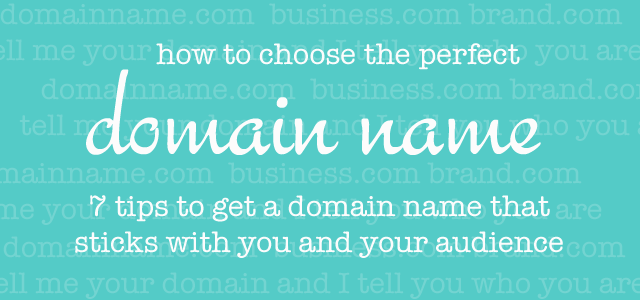I taught my first Beginner Blogging Workshop and in the process I wanted to collect all my tips for choosing a domain name which will be with you and your website for a long time. So get a piece of paper and a pen and start brainstorming, keeping my suggestions in mind.
1. Your domain name should reflect what your website is about
Back in the 90ies companies did come up with names that did not really give away what the website was about. If you had never heard it, you’d have no clue what google.com or yahoo.com was about. That was ok for them then, when the internet was only sparsely populated and they had some kick ass service backed by patented technology which resulted in the name becoming an action (Have you googled today? I think you did 😉 ). Today though it’s a different story. Look at the bigger online companies that recently emerged. You can sort of guess what pinterest.com or instagram.com are about. Even twitter.com allows for some association as to what the core of the site is. The angle here that the website IS the company. If the company already exists, and now you are simply adding an online presence, you would go with your established company name, naturally.
2. Use natural words
Along the same line is my suggestion to use natural words in their correct spelling. I don’t think naming your website danidesignz.com makes you any cooler than using danidesigns.com. You want to come across as a person who knows how to spell (I know, this coming from the lady who probably has 2 typos in this sentence alone 😉 But I want you to be better!) Also stay away from sounds. The sweet Steffi from ohhhmhhh.de has regretted her name choice several times. Just recently her website was announced at a conference in a very…uhm…shall we say sensual way. Natural words will not only help with showing up in search engine results, they also help with my next tip.
3. Make sure it’s pronounceable in both directions
Imagine you are at a blogger meeting and people ask you ‘What’s your website?’ and you say ‘yumalicous.com‘, from that they will not know what to type into the address bar yummylicious.com maybe jummoliciouz.com? However, if you image my friend Lindsey at the same conference, she just says ‘momandwife.com‘ and that name folks should be able to type 🙂
4. Make it short
My very first website was called silentranksproductions.org. Back then I thought it was great, because it was all about creativity from and for Military significant others (they are also known as the silent ranks). It wasn’t long until readers and business partners started calling it silent ranks, which was not my website but someone else’s. People will naturally shorten long names, so why not use the short version to begin with. thereisjustnopointinreallylongdomainnames.com
5. No hyphens, no numbers
There is a movement to just put all the words you want to say together in one. The brain is the greatest computer of them all and has no problems decoding, always striving for meaningful entities. You can see this trend in hashtags #, used in twitter or instagram for example to signal keywords for search. Using hyphens is an ok work around if you want a certain name that is already taken. myname.com was taken so you chose my-name.com instead. The problem, you always have to say, my website is called “my hyphen name dot com“, which is a buzz kill if you ask me and you run into the risk of people going to the other website instead of your hyphen site.
My tip number 2 also speaks against using numbers in your domain. It might have been the coolest thing to call 1-800-MIXALOT but it is not anymore! Holly from decor8.com also told me she would not use this number again because she has people calling the site “decor eight” instead of “decorate“.
6. Get the .com unless you have country specific content
The .com top-level domain (TLD – domain ending) stands for commercial domains and are primarily used by businesses, however over time it has become THE domain ending of them all unless of course you have a country specific site. If you blog in German from Germany then you should totally get the .de domain, same for other countries. If you are a non profit organization naturally the .org ending would be a smart choice for you. But any other ending like .net. biz. .info and so on just tell me that there is a .com for it and it will always have the “right of way” because it was there first. Now, there are successful sites that stared with a .net like sweetopia.net. Yet the ending was probably chosen because the matching .com was gone already and is now parked (not used for content, just showing ads). I’d also be careful using other country codes for catchy-ness purposes I do like lemon.ly as a website and as a name, however the .ly is the “country code” (top-level domain) for Libya and especially if you want to establish your website as a brand you have to be careful with that.
7. Make sure it’s available
All my tips are fine and dandy but they will be no good if the domain name you come up with is already owned by someone else. There are companies who specialize in buying domain names in hopes to resell them to interested parties for a higher price tag. Whereas I used to recommend godaddy for domain and website hosting, I now favor bluehost.com, their service is just far better and I am in the process of moving all my domains over there. You can check the availability of your domain name right here:
So? Was your domain name available? What did you come up with? Do you have other tips for domain name newbies?
Dani!

